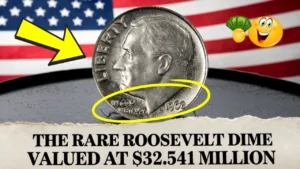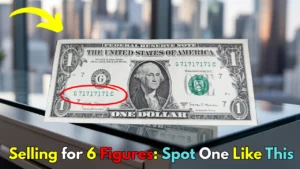Lincoln Wheat Penny Worth $305K: What if I told you that a penny — yes, a regular-looking, copper-colored Lincoln Wheat Penny — could be worth more than a luxury car or even a house? Sounds wild, right? But it’s absolutely true. A rare version of the Lincoln Wheat Penny has fetched up to $305,000 at auction, and here’s the kicker — some of these valuable coins might still be floating around in everyday circulation.
Whether you’re a casual coin collector or just someone who drops spare change in a jar, you might already have a tiny fortune in your possession. In this article, you’ll discover what makes this unassuming penny so valuable, how to spot one, and what to do if you think you’ve struck copper gold
What Is the Lincoln Wheat Penny?
The Lincoln Wheat Penny, also known as the Wheat Cent, is a U.S. coin minted from 1909 to 1958. It gets its name from the two wheat stalks engraved on the reverse side, framing the denomination “One Cent.” On the front, it features the iconic profile of Abraham Lincoln.
While most of these pennies are only worth face value, a select few — due to minting errors, rare variations, or pristine condition — have become the Holy Grails of coin collecting.
The Fascinating History Behind the Wheat Penny
Introduced in 1909 to commemorate the 100th anniversary of Abraham Lincoln’s birth, the Wheat Penny was the first U.S. coin to feature a real person. Designed by Victor David Brenner, it replaced the Indian Head penny and marked a shift in American coin design.
Key Historical Milestones
| Year | Event |
|---|---|
| 1909 | First Lincoln Wheat Penny minted (with “VDB” initials) |
| 1914 | One of the rarest versions created in Denver (1914-D) |
| 1943 | The famous Steel Penny minted due to WWII copper shortages |
| 1955 | The infamous Double Die Obverse error coin appears |
| 1958 | Last year the wheat stalk design was used |
Many of these historical variants are highly collectible today, but one version stands out…
Why Is This Penny Worth Over $300K?
The penny that reached $305,000 at auction is no ordinary copper coin. It’s a 1943 Bronze Lincoln Wheat Penny, and it shouldn’t even exist.
So, what’s the big deal?
During World War II, the U.S. Mint replaced copper pennies with zinc-coated steel to save copper for the war effort. But somehow, a few copper planchets (blanks) from 1942 were mistakenly struck in 1943 — resulting in a very limited number of bronze 1943 pennies.
These “errors” were incredibly rare — estimates suggest fewer than 20 exist. And collectors are willing to pay top dollar to own one.
How to Identify the $305K Wheat Penny
Here’s what to look for if you’re checking your coin jar or inherited collection:
Key Features of the 1943 Bronze Wheat Penny
- Date: 1943
- Color: Brownish-copper (not silver-gray like steel)
- Magnet Test: Not magnetic (steel cents are magnetic)
- Weight: About 3.11 grams (vs. 2.7 grams for steel)
| Feature | 1943 Steel Penny | 1943 Bronze Penny |
|---|---|---|
| Color | Silvery gray | Brown/copper |
| Magnetic? | Yes | No |
| Value | ~$0.10–$1 | Up to $305,000 |
TIP: If you find a 1943 penny that isn’t magnetic, do NOT clean it. Have it evaluated by a professional grading service like PCGS or NGC.
Valuable Coin Variations & Their Prices
While the 1943 Bronze Penny is the superstar, other Wheat Pennies can also fetch hundreds or even thousands of dollars:
Most Valuable Lincoln Wheat Pennies
| Coin Type | Estimated Value |
|---|---|
| 1943 Bronze Penny | $100,000–$305,000 |
| 1909-S VDB | $700–$2,500+ |
| 1914-D | $200–$3,000 |
| 1955 Double Die | $1,000–$10,000 |
| 1922 No D | $500–$3,000 |
How to Check If You Have a Rare Coin
Here are simple steps to spot valuable coins in your change:
- Look at the Date & Mint Mark – Check for 1909-S, 1914-D, 1943, 1955.
- Use a Magnet – To spot steel vs. bronze in 1943 pennies.
- Inspect for Errors – Like doubling of letters/numbers.
- Weigh the Coin – Get a digital scale; rare ones often differ in weight.
- Compare with Online Databases – Use PCGS, NGC, or CoinTrackers.
Expert Tips to Maximize Your Coin’s Value
- Don’t Clean It! – Cleaning a rare coin can reduce its value significantly.
- Get It Graded – Have your coin certified by a trusted grading company.
- Store It Properly – Use acid-free holders and keep in a dry place.
- Network with Collectors – Join forums or Facebook groups to learn more.
- Sell at Auction – Reputable auction houses often fetch the best prices.
FAQs: What Everyone Wants to Know
Are Wheat Pennies still in circulation?
Yes — though rare, it’s still possible to find them in pocket change or old collections.
How can I tell if my 1943 penny is the valuable one?
If it’s brown/copper and not magnetic, it could be worth a fortune.
Where can I sell a rare penny?
eBay, Heritage Auctions, and Stack’s Bowers are top places — but make sure it’s graded first.
How many 1943 bronze pennies exist?
Experts estimate fewer than 20 known pieces.
What’s the safest way to store valuable coins?
In individual coin holders kept away from humidity, sunlight, and contaminants.
Final Thoughts: Is It Time to Check Your Spare Change?
The next time you empty your pockets or check the old jar in grandma’s attic, take a second look — that tiny, forgotten penny might be a rare Lincoln Wheat Penny worth six figures.
With a rich history, unique variations, and ongoing discoveries, coin collecting isn’t just a hobby — it could be a hidden treasure hunt. So go ahead, flip through those coins. You never know when you’ll uncover a $305,000 surprise.




